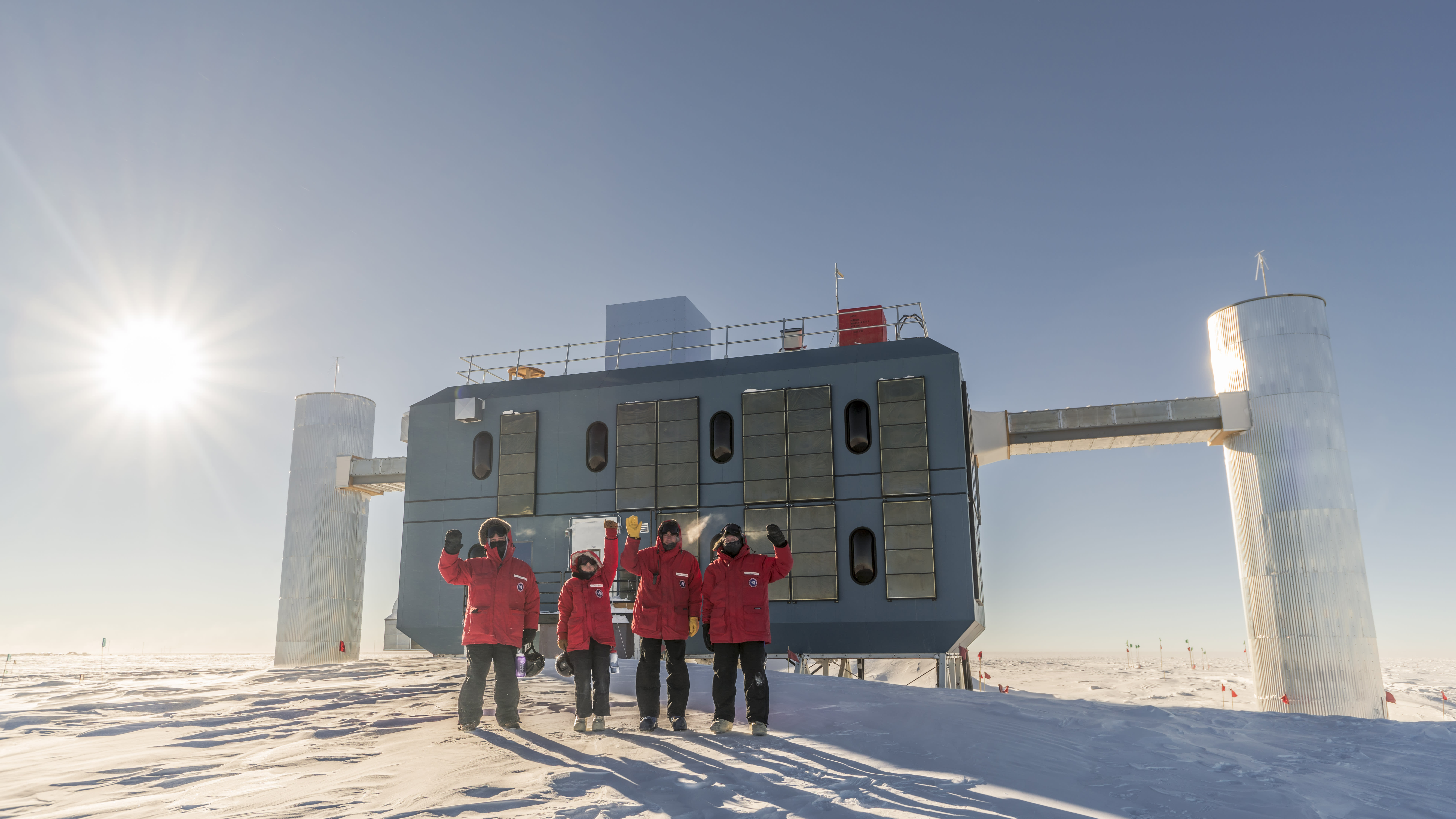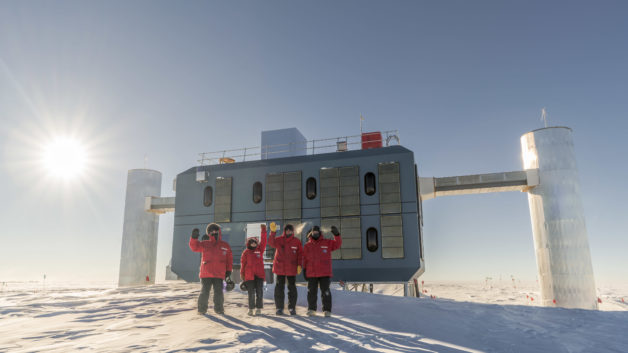This feature was adapted from a release produced by the IceCube Collaboration. Read the original release
It was the beginning of a grand experiment unlike anything the world had ever seen. Ten years ago today, the IceCube Neutrino Observatory fully opened its eyes for the first time.
Over the course of the previous seven years, dozens of intrepid technicians, engineers, and scientists had traveled to the South Pole – one of the coldest, driest, and most isolated places on Earth – to build the biggest, strangest telescope in the world. Crews drilled 86 holes nearly two-and-a-half kilometers deep and lowered a cable strung with 60 basketball-sized light detectors into each hole. The result was a hexagonal grid of sensors embedded in a cubic kilometer of ice about a mile below the surface of the Antarctic ice sheet. On December 18, 2010, the 5,160th light sensor was deployed in the ice, completing the construction of the IceCube Neutrino Observatory.
The purpose of the unconventional telescope was to detect signals from passing astrophysical neutrinos: mysterious, tiny, extremely lightweight particles created by some of the most energetic and distant phenomena in the cosmos. IceCube’s founders believed that studying these astrophysical neutrinos would reveal hidden parts of the universe. Over the course of the next decade, they would be proven right.
IceCube began full operations on May 13, 2011 – ten years ago today – when the detector took its first set of data as a completed instrument. Since then, IceCube has been watching the cosmos and collecting data continuously for a decade.
The Department of Energy’s Lawrence Berkeley National Laboratory (Berkeley Lab) played a significant role in IceCube’s conception and construction, and continues to play an integral role in data analysis.
Berkeley Lab scientists developed the key concept for the IceCube data acquisition system and built the prototypes and data acquisition electronics for the 5,460 optical modules. Berkeley Lab scientists also had key roles in developing the on-line software. Among the highlights, the Lab researchers made it possible to deploy sophisticated data acquisition systems in each of the 5,160 optical modules that are buried under a mile of Antarctic ice, and have them continue to work reliably for decades, while maintaining timing calibrations between modules to less than 3 billionths of a second.
More recently, Berkeley Lab staff, students, and postdoctoral researchers have been principal authors on many publications using IceCube data, on topics including neutrino absorption in the Earth, the flavor composition and flux of astrophysical neutrinos, and studies of atmospheric neutrinos and cosmic rays. A Berkeley Lab team also found one of the most energetic events detected by IceCube, with a deposited energy about 300-times higher than the energy of the protons accelerated at CERN’s Large Hadron Collider. NERSC, an Office of Science User Facility located at Berkeley Lab, also contributes to IceCube: its advanced computing resources provide computing cycles for data analysis and simulation, and a home for IceCube to store its raw data – about 4 petabytes at last count.
“Over the past decade, it has been extremely gratifying to see the hard work that we put into building IceCube pay off,” said Berkeley Lab physicist Spencer Klein, who has been a part of the IceCube collaboration since 2004. “We have made every measurement that we had proposed, plus a large number of new studies that were not in the original IceCube proposal, either because we had not thought of them, or because we did not dare commit to making them work.”
Bob Stokstad, also a Berkeley Lab physicist and longtime colleague, added, “The Nuclear Science, Physics, Engineering and Computational Science Divisions all contributed members to the Berkeley Lab group that helped design and construct IceCube. It was one of the most successful examples of teamwork that I’ve ever encountered.”
During its first few years of operation, IceCube accumulated vast amounts of data, but it wasn’t until 2013 that the observatory yielded its first major results. That year, the collaboration announced the first evidence for neutrinos from outside our galaxy with the detection of two very energetic neutrino events and, soon after, the observation of 26 additional very high energy events. Since then, the IceCube collaboration has detected more astrophysical neutrinos and has made strides in the fields of neutrino physics, astrophysics, and multimessenger astronomy. From pinpointing potential neutrino sources to the recent detection of a Glashow resonance event, IceCube has proven again and again the value of capturing perhaps the most elusive particles in the universe.
This success has led to a growing cohort of scientists using state-of-the-art techniques to analyze IceCube data. What started with a couple dozen dreamers is now the international IceCube Collaboration: a diverse group of over 350 scientists from 53 institutions in 12 countries across five continents. And the collaboration is actively working to inspire the next generation of physicists by bringing education and outreach activities to people of all ages and backgrounds. In the last decade, IceCube produced a web comic and translated it into 10 languages, created IceCube-themed arts and crafts, hosted countless South Pole webinars, supported multiple art installations, brought educators to the South Pole, and much more.
To celebrate this 10th anniversary milestone, keep an eye on the IceCube website and social media profiles – and follow the hashtag #IceCube10.
The IceCube Neutrino Observatory is funded primarily by the National Science Foundation and is headquartered at the Wisconsin IceCube Particle Astrophysics Center, a research center of UW–Madison. IceCube’s research efforts, including critical contributions to the detector operation, are funded by agencies in Australia, Belgium, Canada, Denmark, Germany, Japan, New Zealand, Republic of Korea, Sweden, Switzerland, the United Kingdom, and the United States.
###
Founded in 1931 on the belief that the biggest scientific challenges are best addressed by teams, Lawrence Berkeley National Laboratory and its scientists have been recognized with 14 Nobel Prizes. Today, Berkeley Lab researchers develop sustainable energy and environmental solutions, create useful new materials, advance the frontiers of computing, and probe the mysteries of life, matter, and the universe. Scientists from around the world rely on the Lab’s facilities for their own discovery science. Berkeley Lab is a multiprogram national laboratory, managed by the University of California for the U.S. Department of Energy’s Office of Science.
DOE’s Office of Science is the single largest supporter of basic research in the physical sciences in the United States, and is working to address some of the most pressing challenges of our time. For more information, please visit energy.gov/science.

